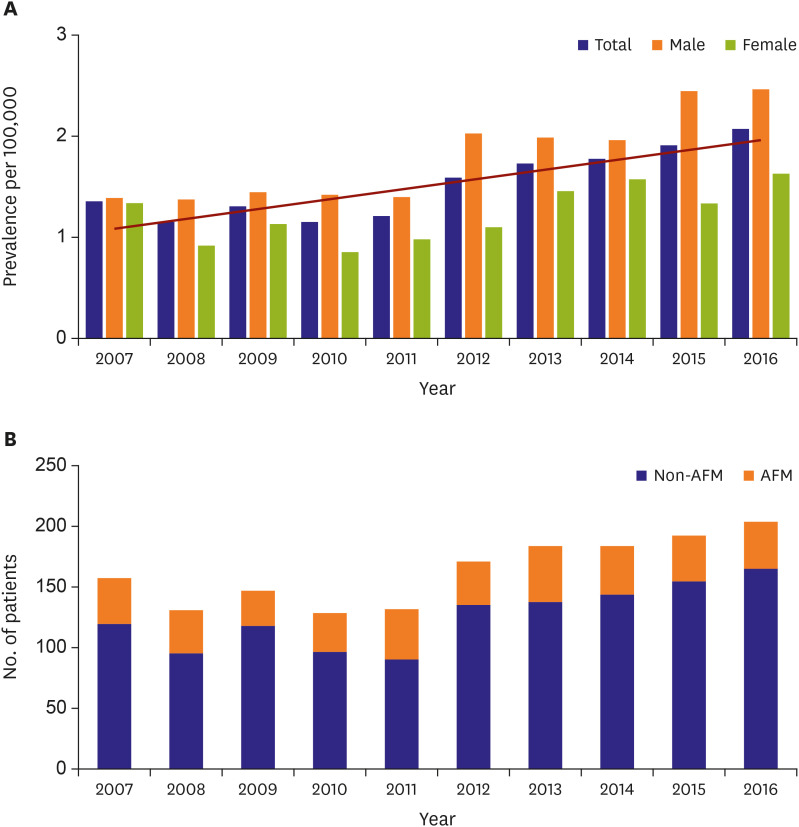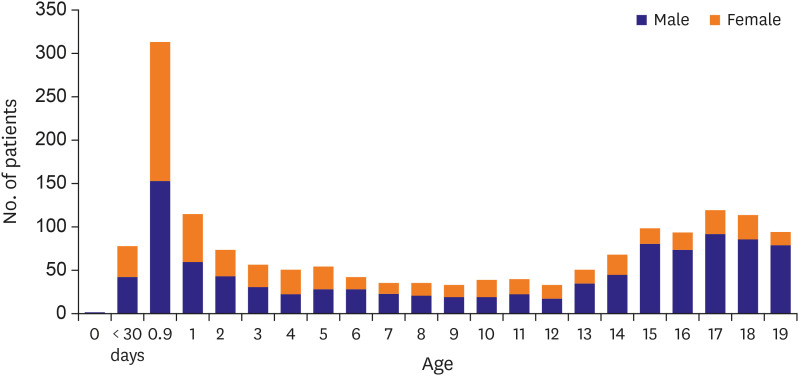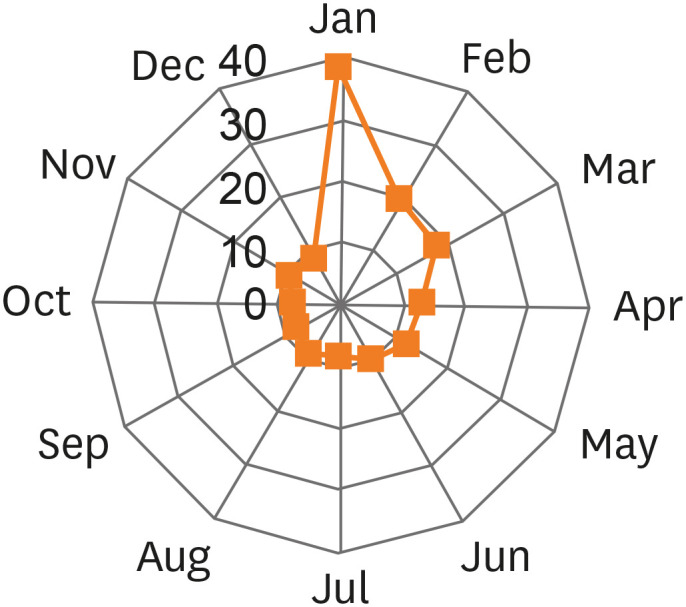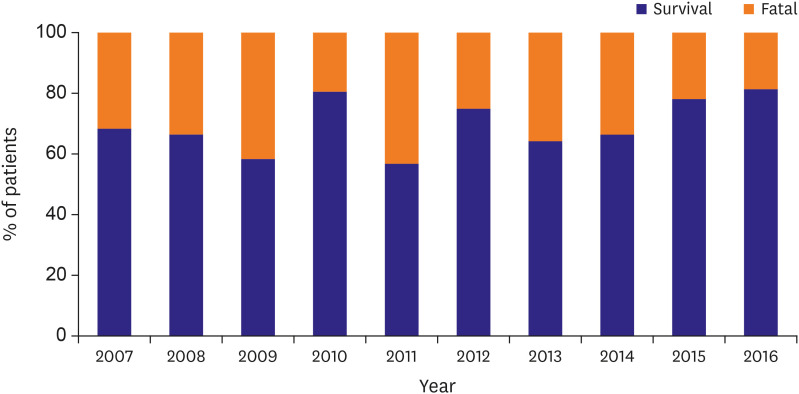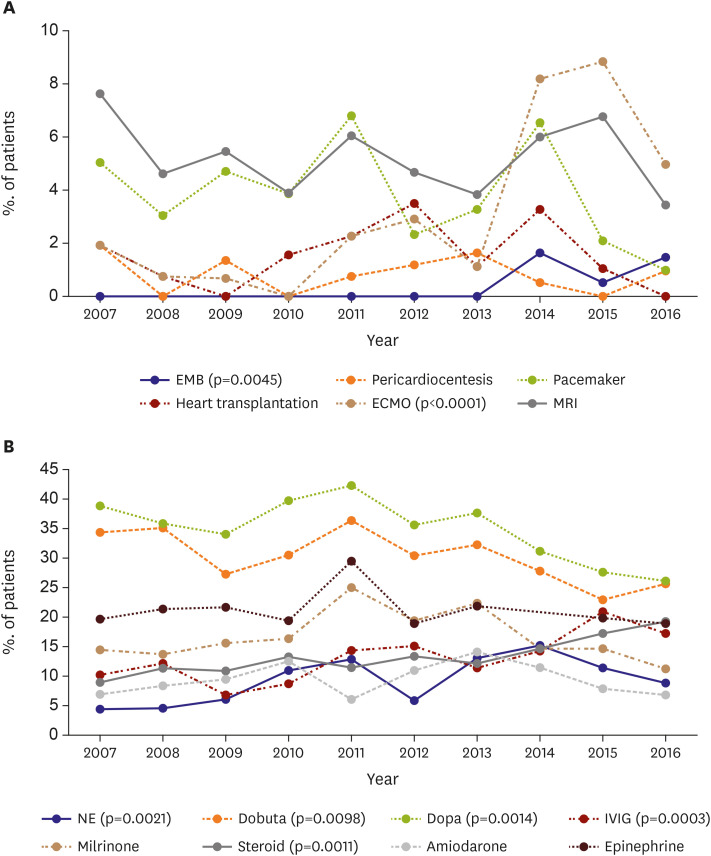Acute Myocarditis in Children: a 10-year Nationwide Study (2007–2016) based on the Health Insurance Review and Assessment Service Database in Korea
- Affiliations
-
- 1Biomedical Research Institute of Pusan National University Hospital, Busan, Korea
- 2Department of Pediatrics, Gyeongsang National University Changwon Hospital, Changwon, Korea
- KMID: 2508290
- DOI: http://doi.org/10.4070/kcj.2020.0108
Abstract
- Background and Objectives
We performed a nationwide study to assess the incidence, treatment patterns, and outcomes of acute myocarditis in Korean children.
Methods
The nationwide incidence, treatment patterns, and outcomes of acute myocarditis in Korean children were assessed using data between 2007 and 2016 from the Health Insurance Review and Assessment database.
Results
We investigated 1,627 children during the study period. The overall incidence of acute myocarditis was 1.4 per 100,000 children in 2007 and 2.1 per 100,000 children in 2016, which indicates a significant increase in the trend over time. A bimodal age distribution was observed with a larger peak in infancy and a smaller peak in the mid-teenage years. No sex difference was observed in the incidence rate of acute myocarditis in children aged ≤5 years (373 boys vs. 366 girls); however, the incidence rate of acute myocarditis in adolescents aged ≥13 years showed significant male preponderance (482 boys vs. 152 girls). Acute fulminant myocarditis occurred in 371 children (22.8%) who needed extracorporeal membrane oxygenation and/or mechanical ventilator support. Of the 371 children with acute fulminant myocarditis, 258 (69.5%) survived. The survival rate of children with acute fulminant myocarditis remained nearly identical over the 10-year study period.
Conclusions
This was the first nationwide epidemiological study to investigate acute myocarditis in Korean children. In our view, this study would help clinicians in decisionmaking and planning for optimal management of acute myocarditis in children.
Keyword
Figure
Cited by 4 articles
-
Pediatric Acute Myocarditis: Current Approach to Diagnosis and Treatment
Soo-Jin Kim
Korean Circ J. 2020;50(11):1023-1025. doi: 10.4070/kcj.2020.0389.Epidemiology and Clinical Features of Myocarditis/Pericarditis before the Introduction of mRNA COVID-19 Vaccine in Korean Children: a Multicenter Study
Hwanhee Park, Ki Wook Yun, Kyung-Ran Kim, Seung Ha Song, Bin Ahn, Doo Ri Kim, Gi Beom Kim, June Huh, Eun Hwa Choi, Yae-Jean Kim
J Korean Med Sci. 2021;36(32):e232. doi: 10.3346/jkms.2021.36.e232.Clinical Features of Patients Presenting to the Emergency Department With Cardiovascular Adverse Reactions After COVID-19 mRNA Vaccination
Tae Hoon Oh, Seon Hee Woo, Sungyoup Hong, Carol Lee, Woon Jeong Lee, Si Kyoung Jeong
J Korean Med Sci. 2022;37(9):e73. doi: 10.3346/jkms.2022.37.e73.Epidemiological Characteristics and Outcome of Myocarditis and Pericarditis Temporally Associated With BNT162b2 COVID-19 Vaccine in Adolescents: Korean National Surveillance
Bin Ahn, Seung Hwan Shin, Myung-Jae Hwang, HyoSug Choi, Sara Na, Sangshin Park, Jue Seong Lee, Young June Choe, Yoonsun Yoon, Kyoungsan Seo, Jong Hee Kim, Hyun Mi Kang
J Korean Med Sci. 2024;39(49):e317. doi: 10.3346/jkms.2024.39.e317.
Reference
-
1. Arola A, Pikkarainen E, Sipilä JO, Pykäri J, Rautava P, Kytö V. Occurrence and features of childhood myocarditis: a nationwide study in Finland. J Am Heart Assoc. 2017; 6:6.
Article2. Saji T, Matsuura H, Hasegawa K, et al. Comparison of the clinical presentation, treatment, and outcome of fulminant and acute myocarditis in children. Circ J. 2012; 76:1222–1228. PMID: 22307381.
Article3. Lieberman EB, Hutchins GM, Herskowitz A, Rose NR, Baughman KL. Clinicopathologic description of myocarditis. J Am Coll Cardiol. 1991; 18:1617–1626. PMID: 1960305.4. Hsiao HJ, Hsia SH, Wu CT, et al. Clinical presentation of pediatric myocarditis in Taiwan. Pediatr Neonatol. 2011; 52:135–139. PMID: 21703554.
Article6. Ghelani SJ, Spaeder MC, Pastor W, Spurney CF, Klugman D. Demographics, trends, and outcomes in pediatric acute myocarditis in the United States, 2006 to 2011. Circ Cardiovasc Qual Outcomes. 2012; 5:622–627. PMID: 22828827.
Article7. Durani Y, Egan M, Baffa J, Selbst SM, Nager AL. Pediatric myocarditis: presenting clinical characteristics. Am J Emerg Med. 2009; 27:942–947. PMID: 19857412.
Article8. Klugman D, Berger JT, Sable CA, He J, Khandelwal SG, Slonim AD. Pediatric patients hospitalized with myocarditis: a multi-institutional analysis. Pediatr Cardiol. 2010; 31:222–228. PMID: 19936586.
Article9. Freedman SB, Haladyn JK, Floh A, Kirsh JA, Taylor G, Thull-Freedman J. Pediatric myocarditis: emergency department clinical findings and diagnostic evaluation. Pediatrics. 2007; 120:1278–1285. PMID: 18055677.
Article10. Fairweather D, Cooper LT Jr, Blauwet LA. Sex and gender differences in myocarditis and dilated cardiomyopathy. Curr Probl Cardiol. 2013; 38:7–46. PMID: 23158412.
Article11. Kytö V, Sipilä J, Rautava P. The effects of gender and age on occurrence of clinically suspected myocarditis in adulthood. Heart. 2013; 99:1681–1684. PMID: 24064227.
Article12. McCarthy RE 3rd, Boehmer JP, Hruban RH, et al. Long-term outcome of fulminant myocarditis as compared with acute (nonfulminant) myocarditis. N Engl J Med. 2000; 342:690–695. PMID: 10706898.
Article13. Sankar J, Khalil S, Jeeva Sankar M, Kumar D, Dubey N. Short-term outcomes of acute fulminant myocarditis in children. Pediatr Cardiol. 2011; 32:885–890. PMID: 21574064.
Article14. Anderson BR, Silver ES, Richmond ME, Liberman L. Usefulness of arrhythmias as predictors of death and resource utilization in children with myocarditis. Am J Cardiol. 2014; 114:1400–1405. PMID: 25200339.
Article15. Miyake CY, Teele SA, Chen L, et al. In-hospital arrhythmia development and outcomes in pediatric patients with acute myocarditis. Am J Cardiol. 2014; 113:535–540. PMID: 24332245.
Article16. Wu ET, Huang SC, Chen YS, Wang JK, Wu MH, Ko WJ. Children with fulminant myocarditis rescued with extracorporeal membrane oxygenation. Heart. 2006; 92:1325–1326. PMID: 16908709.
Article17. Wu HP, Lin MJ, Yang WC, Wu KH, Chen CY. Predictors of extracorporeal membrane oxygenation support for children with acute myocarditis. BioMed Res Int. 2017; 2017:2510695. PMID: 28584814.
Article18. Jung SY, Shin HJ, Jung JW, et al. Extracorporeal life support can be a first-line treatment in children with acute fulminant myocarditis. Interact Cardiovasc Thorac Surg. 2016; 23:247–252. PMID: 27165733.
Article19. Hia CP, Yip WC, Tai BC, Quek SC. Immunosuppressive therapy in acute myocarditis: an 18 year systematic review. Arch Dis Child. 2004; 89:580–584. PMID: 15155409.
Article20. Robinson J, Hartling L, Vandermeer B, Klassen TP. Intravenous immunoglobulin for presumed viral myocarditis in children and adults. Cochrane Database Syst Rev. 2015; CD004370. PMID: 25992494.
Article21. Matsuura H, Ichida F, Saji T, et al. Clinical features of acute and fulminant myocarditis in children-2nd nationwide survey by Japanese Society of Pediatric Cardiology and Cardiac Surgery. Circ J. 2016; 80:2362–2368. PMID: 27725476.22. Drucker NA, Colan SD, Lewis AB, et al. Gamma-globulin treatment of acute myocarditis in the pediatric population. Circulation. 1994; 89:252–257. PMID: 8281654.
Article
- Full Text Links
- Actions
-
Cited
- CITED
-
- Close
- Share
- Similar articles
-
- Emerging New Era of Mobile Health Technologies
- Incidence and Treatment Pattern of Extremity Soft Tissue Sarcoma in Korea, 2009-2011: A Nationwide Study Based on the Health Insurance Review and Assessment Service Database
- The CDA Book
- Incidence and Prevalence of Type 1 Diabetes Mellitus among Korean Children and Adolescents between 2007 and 2017: An Epidemiologic Study Based on a National Database
- Epidemiologic Study on Kawasaki Disease in Korea, 2007-2014: Based on Health Insurance Review & Assessment Service Claims

